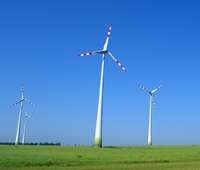October 25, 2013 report
IEA ups wind power target for global electricity by 2050

(Phys.org) —The new report from the International Energy Agency (IEA) is out with a forecast that wind may generate 18 percent of world electricity by 2050, which is a target higher than the 12 percent estimate posted in its earlier roadmap report in 2009. Wind power currently generates 2.6 percent of the world's electricity. The new report that came out earlier this month titled Technology Roadmap: Wind Energy - 2013 edition, details the advances in technology that make the rise from the current 2.6 percent possible. In this 2050 scenario, it is offshore wind that will drive much of the growth, with lower costs, down 45 percent, helping to boost offshore's share of wind power from about 2 percent now to 6 percent in 2020 and 25 percent in 2050. The report carries a number of key findings, some of which are as follows:
Since 2008, wind power deployment has more than doubled, approaching 300 GW cumulative installed capacities led by China (75 GW), the United States (60 GW) and Germany (31 GW). The report notes that some European countries already draw 15 percent to 30 percent of their electricity from wind power, thanks to improvements in forecasting, increased interconnections, demand-side response and storage. Policy support has been instrumental in stimulating the growth.
At the same time, the geographical pattern of deployment is rapidly changing. Countries belonging to the Organization for Economic Cooperation and Development (OECD) led early wind development, but from 2010 non-OECD countries installed more wind turbines. After 2030, non-OECD countries will have more than 50 percent of global installed capacity. The cost of land-based wind power is close to competitive with other sources of electricity in an increasing set of circumstances. In countries such as Brazil, wind power has prevailed over fossil alternatives in auctions for long-term power purchases, thanks to the hedge it provides against possible future price increases for fossil fuels. The new report says that China will replace Europe as the top wind power producer by 2020 or 2025, with the U.S. ranking third.
On two other notes, wind power is now being deployed in countries with good resources without any dedicated financial incentives. The very technology of wind power continues to improve rapidly, and costs of generation from land-based wind installations continue to fall. Turbines are higher, stronger and lighter, while masts and blades are growing faster than rated capacity. What's more, turbines are capturing lower-speed winds and producing more regular output.
Nonetheless, the IEA points to numerous challenges for the global wind sector going forward. Those challenges include grid integration, funding and overall public acceptance. For offshore wind, the report said, much remains to be done to develop appropriate large-scale systems and to reduce costs.
"To achieve high penetrations of variable wind power without diminishing system reliability, improvements are needed in grid infrastructure and in the flexibility of power systems as well as in the design of electricity markets." said the IEA. The roadmap both names the challenges and proposes a set of actions to overcome them.
The IEA is an autonomous organization that was founded in response to the 1973-1974 oil crisis. Initially, the IEA took on the role of helping countries coordinate a collective response to disruptions in the oil supply through the release of emergency oil stocks to the markets. Since then the IEA has evolved and now considers itself at the heart of global dialogue on energy. The agency provides statistics, analysis and recommendations.
More information: www.iea.org/publications/freep … n/name,43771,en.html
© 2013 Phys.org



















